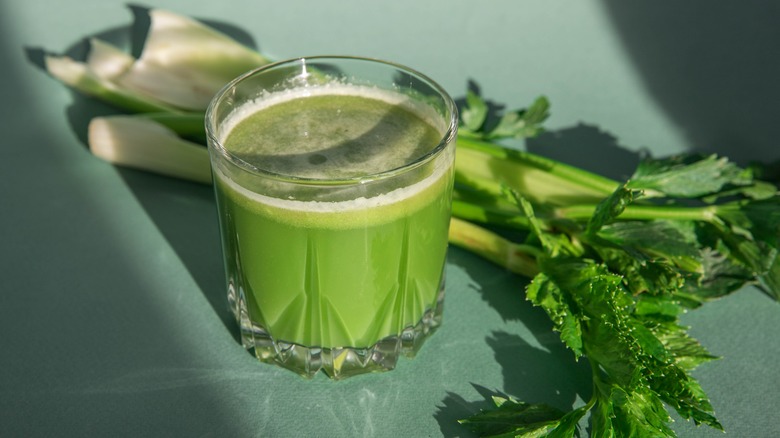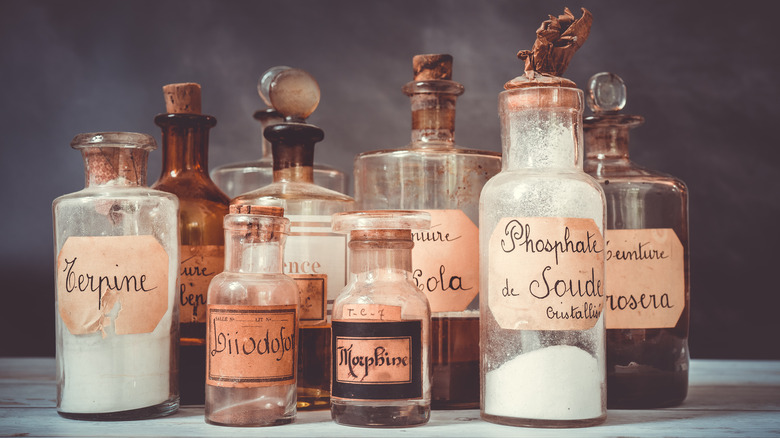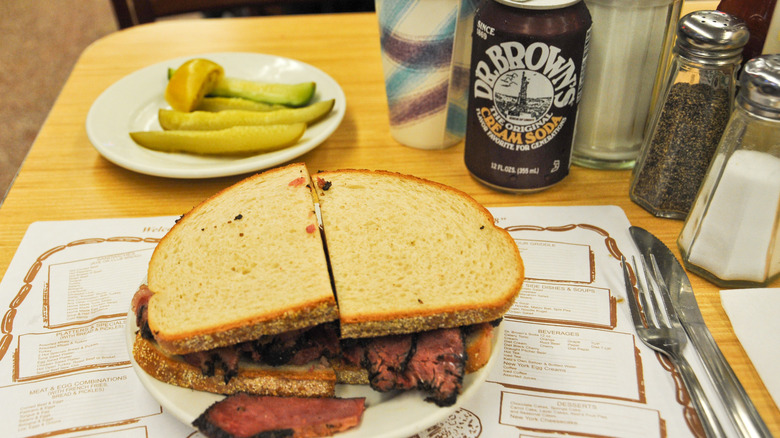The Origins Of Celery Soda Have An Interesting Medical Connection
Olde Brooklyn Bagel Shoppe in Clinton Hill, Brooklyn, stands as a monument to an era in time back when delis and soda shops were at the focal point of city living. Walking through the establishment evokes the feeling of traveling through time back to the 1920s. With its art deco aesthetic and vintage décor, its atmosphere is punctuated by the pungent aroma of fresh baked everything bagels, smoked salmon, and grilled tuna melts with extra onions. It's also one of the few places you can still find the esoteric celery soda that proliferated through Jewish delis of New York during the late 1800s and early 1900s.
In the context of today's sweet-focused soda industry, the idea of a savory herbaceous celery soda seems like an idea that's doomed to fail. But given the modern infatuation with kombuchas, probiotic sodas, and juice cleanses, the concept of a celery-flavored health beverage doesn't seem so out of left field. Shortly after its debut in the 1860s, celery soda became a favorite libation among the New York Jewish community. According to My Jewish Learning, celery flavor was essentially the pumpkin spice of the 1930s. But celery soda's spike in popularity at the time wasn't entirely due to its flavor alone, but rather by the brand's association with medicinal superfood qualities of celery, which allowed the drink to gain unprecedented notoriety in the early 20th century.
Soda's healthy era
Celery soda is the product of its time, defined by immigration and the reconciliation of traditional tastes with contemporary food trends and entrepreneurial innovations. In the late 1800s, during a wave of immigration from Eastern Europe to the U.S., seltzers and sodas were all the rage in America. In their earliest, most sodas were initially intended as medicinal tonics either to cure depression, boost energy, or settle stomachs, and over time, these tonics were sweetened to make them more palatable. According to Medical Bag, 7Up started with a mood-stabilizer as a main ingredient, Dr Pepper was marketed as a "brain-tonic," and as we all know, Coca-Cola originally contained cocaine, being sold as a health and vitality tonic.
Like many of its contemporaries, celery soda started as a health tonic. Though not much is known about the inventor, the story goes that celery soda was created by a Dr. Brown in 1868 with the intention of making a celery tonic to quell upset stomachs and provide nourishment to Jewish immigrant children in the Lower East Side and Williamsburg, according to Atlas Obscura. Celery was the in-vogue superfood of the time; it had gained a foothold in the American agriculture industry some years prior and became incorporated in everything from hand soaps to chewing gum (according to Serious Eats). Celery itself became associated with health and medicine, as it was believed to cure insomnia, headaches, and even malaria.
Cel-Ray is here to stay
As Dr. Brown continued refining his celery tonic, he added sweeteners making it more palatable. By 1886 the concoction was bottled, dropped "tonic" from the name, and marketed as Dr. Brown's Cel-Ray Soda (via My Jewish Learning). The soft drink reached the height of its popularity around the turn of the century among Jewish immigrants, but why?
For one, it was made by Jewish people, for Jewish people; immigrants formerly involved in the beet sugar industry of their homelands translated work experience to the American soda industry. The Ashkenazim were already familiar with celery as a frequent ingredient of their traditional cuisine and familiar with botanical drinks like Ukrainian kvass made from fermented beets, bread, and even lettuce (via Serious Eats).
Secondly, Cel-Ray pairs well with other Jewish deli foods like pastrami and brisket, providing refreshing effervescence that complement the salt and fat of popular deli meats. During the early 1900s, Cel-Ray developed a cult-like following among the patrons of Jewish delis. Comedian Mel Brooks even reflects fondly on his (pre-Depression era) childhood memories of salami sandwiches washed down with a Cel-Ray in his autobiography "All About Me." Though celery soda was born out of medicinal exploration, it persists to this day as a hidden gem in the back of bodega fridges, a radiant green-bottled source of nostalgia. But as trends come back into fashion, it wouldn't be surprising to see new renditions of Cel-Ray lining the shelves of health food stores and kombucha shops.


